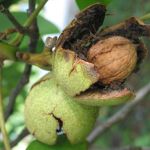| Common Name: |
English Walnut |
| Botanical Name: |
Juglans regia |
| Genus: |
Juglans |
| Family: |
Juglandaceae |
| Native Location: |
SE Europe to Himalayas, SW China, C Russia |
| Cultivation: |
Deep, rich, well-drained soil in sun. For reliable crops of good quality nuts, plant self-fertile cultivars of J. nigra rather than the wild species. Remove badly placed and dead branches in winter. Leaves may be marked by bacterial leaf blotch and blight. Young shoots and flowers may be damaged by frost in cold sites. |
| Propagation: |
By seed sown when ripe, or in spring after stratifying (species only); by whip-and-tongue grafting; by chip-budding on to J. nigra. |
| Harvest: |
Leaves are picked during the growing season and dried for use in infusions and liquid extracts. Fruits are collected unripe, or when ripe in autumn, and separated into husks, shells, and kernels ("nuts"). Green rinds are used fresh for infusions; husks are infused for dye, and kernels pressed for oil. Inner bark is collected in autumn and dried for decoctions. |
| Variations: |
Broadview
Is very hardy; it produces large crops of easily cracked nuts at an early age.
Hansen
Is small and very hardy; produces round, thin-shelled nuts at an early age.
Laciniata
(Cut-Leafed Walnut)
Has slightly pendent branches and deeply cut leaflets. |
| Height: |
35m (120ft) |
| Width: |
20m (70ft) |
| Hardiness: |
Z5-8 |
| Parts Used: |
Leaves, bark, fruits (unripe rind), kernels (hu tao ren), oil. |
| Properties: |
A bitter, astringent herb that is expectorant and laxative, soothes irritated tissues, and dissolves kidney stones. It controls many disease-causing organisms and has anti-cancer properties. |
| Medicinal Uses: |
Internally for constipation, chronic coughs, asthma, and urinary stones (leaves); diarrhea and anemia (rind); and menstrual problems and dry skin conditions (oil). Externally for eczema, herpes, eruptive skin complaints, eye inflammations, and hair loss. Regarded in traditional Chinese medicine as a tonic for weak kidney energy. |
| Culinary Uses: |
Walnuts are an important ingredient of cakes, cookies, desserts, ice cream, and various savory dishes and sauces, including Middle Eastern chicken dishes, Provençal raito (salt cod), and Italian pesto sauce for pasta. Walnut oil is a choice salad oil, used especially with fruits or herb-flavored vinegars. Unripe fruits are pickled, preserved in syrup, and made into the French liqueur brou de noix. Leaves are used for tea and for wrapping cheeses. |
| Economic Uses: |
Leaves and husks yield brown dye, used in hair tints and conditioners for dark hair. Wood is used in furniture, veneers, and gunstocks. Oil is used for culinary purposese, and in cosmetics and artists' paints. Walnut meal is used as a thickening agent in the food industry. |
| Bibliography: |
Encyclopedia of Herbs by Deni Brown Copyright © 1995, 2001 Dorling Kindersley Limited Pg 247 |
